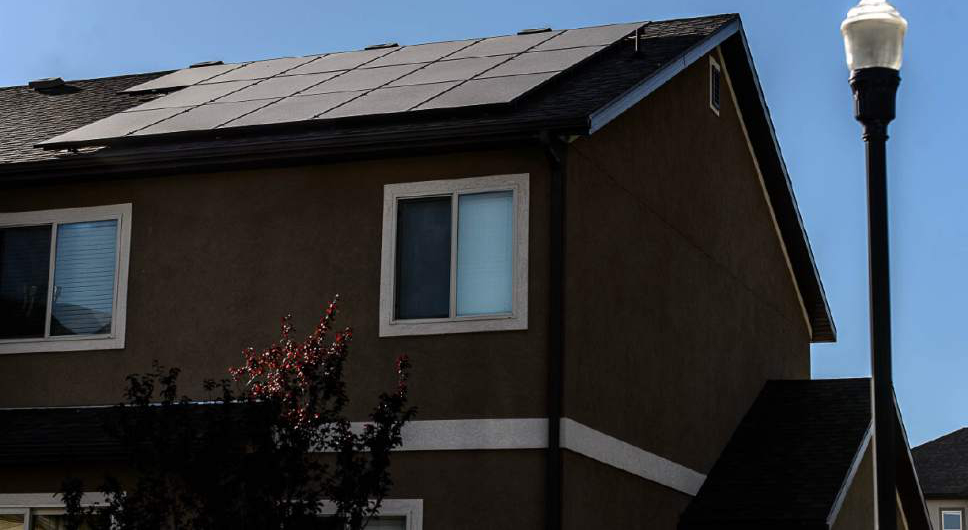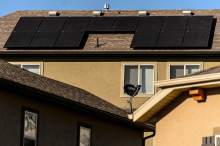This is an archived article that was published on sltrib.com in 2016, and information in the article may be outdated. It is provided only for personal research purposes and may not be reprinted.
Nearly 8,000 Utahns have made a personal investment in the power of the sun this year, and the state expects thousands more to join them — making 2016 the biggest year for solar by far.
But this news isn't all sunny — processing solar tax credits could cost the state $42 million, and industry leaders say residents rushing to jump on the solar bandwagon could fall prey to unscrupulous deals.
About 7,700 Utahns signed up for Rocky Mountain Power's net metering program between January and June, according to company numbers. The utility had 3,200 net metering customers in Utah at the end of 2015.
Laura Nelson, executive director of the Governor's Office of Energy Development (OED), told lawmakers during a July 13 interim session that Utah is projected to process more than 12,000 applications for residential solar tax credits this year. Should that projection pan out, she said, it would mean more rooftop solar arrays would be installed in 2016 than in all past years combined.
While solar is on the rise nationally, rooftop arrays are especially popular in Utah. Rocky Mountain Power had 10,800 net metering customers in Utah as of the end of June, compared to 187 in Idaho and 225 in Wyoming. According to a recently released report from the Frontier Group's Environment America Research and Policy Center, Utah was the fifth-fastest growing state for solar installations in 2015, with 77 watts of solar installed per capita in that year alone. Nevada topped the chart for solar, with 144 watts of solar per capita.
Utah has seen steady rooftop solar growth since about 2012, said Jeffrey Barrett, OED deputy director, but nothing like the past six or seven months.
"The growth curve is basically vertical right now," he said. "It's a remarkable time for this industry."
Utahns are also buying larger rooftop arrays than in the past. In 2012, Barrett said, the average tax credit application involved a 3.5 kilowatt system. This year, he said, the average is closer to 6.5 kilowatts.
Low costs and advancing technology have converged to create the boom, he said.
Solar technology has improved, increasing the performance of household systems, Barrett said, while the price of solar has declined as the market has grown and become more efficient. And at the moment, homeowners can get up to 40 percent of a solar installation refunded on their taxes.
Orem resident Andrew Syme said he had been eyeing rooftop solar for about two years before the numbers hit an important benchmark this spring — the point at which Syme could install a solar array on his roof and completely replace his power bill.
"The whole reason I did it was because the monthly cost for the panels is less than my monthly electricity bills," Syme said. "Right now I generate all my power. I have excess."
Syme said his average electric bill was $170 a month before solar panels. Now, he said, he pays $159 per month for the 20-year home equity loan he used to finance the panels' installation.
Robert Olson, a salesman for Auric Solar, said he too crunched the numbers and decided 2016 was the year to put his money where his mouth was. He was never a big energy user — his last bill two months ago was $35. But now, he said, he pays $60 a month for the loan on his panels and has no power bill.
But a lot of what's making solar so affordable right now, Olson said, are the tax credits — and at least Utah's portion isn't guaranteed to stick around.
So many people are expected to apply for the residential solar tax credit that the state could be looking at spending $42 million on the program. That's a lot more than in the past, Barrett said, and it could cause lawmakers to do a double take in the next session.
"We're looking at a program that's going to have a significant impact on the budget going forward if changes aren't made," Barrett said. "I would be surprised if changes weren't proposed."
Ryan Evans, president of the Utah Solar Energy Assoication, said he hopes lawmakers consider any possible changes carefully. While the cost associated with solar tax credits may be increasing, the benefits — even the financial return — are still worth it, he said.
"For every $20 million in tax credits spent by the state," he said, "$300 million comes back to the state."
Changes or no, Barrett predicted that the state's actions wouldn't have a large impact on Utah's solar trend. Utah's residential solar tax credit is capped at $2,000, but federal tax credits can cover up to 30 percent of a residential solar installation — and those aren't expected to go anywhere.
Derrik Shakespear, vice president of sales at Legend Solar, worries that the current demand for solar could be bad news for the industry in the long run.
Trends like this can lead people to rush into purchasing decisions, which makes them more likely to fall prey to less-than-scrupulous business practices that may be rampant during a boom.
"Right now, so many people are just trusting the idea of solar that they're not even spending the minimal time needed to get the proper exposure to what they're buying," he said.
Shakespear said he's seen two recurring schemes where customers get ripped off. In one, he said, the seller says the panels will come with a warranty, when they in fact come with much more limited guarantees, or none at all.
Other customers, Shakespear said, buy an array from a seller, only to be surprised when a third-party contractor shows up for the installation. A third-party contractor isn't necessarily a bad thing, he said, but it could be a red flag — salespeople sometimes bring in outside contractors to limit their own liability. Customers should know who's going to install their array and shouldn't let themselves be rushed through a sale.
Shakespear said he's concerned these schemes could negatively affect upright operations.
"Our concern is that if people buy something not knowing enough about what they're buying, they could end up unhappy," he said. "So we hope that in five years, solar still has a good name."
At some point, Shakespear said, solar will reach market saturation, and growth will level off as salespeople turn their attention toward new homes and first-time homebuyers.
For now, though, business is pretty good.
Twitter: @EmaPen







